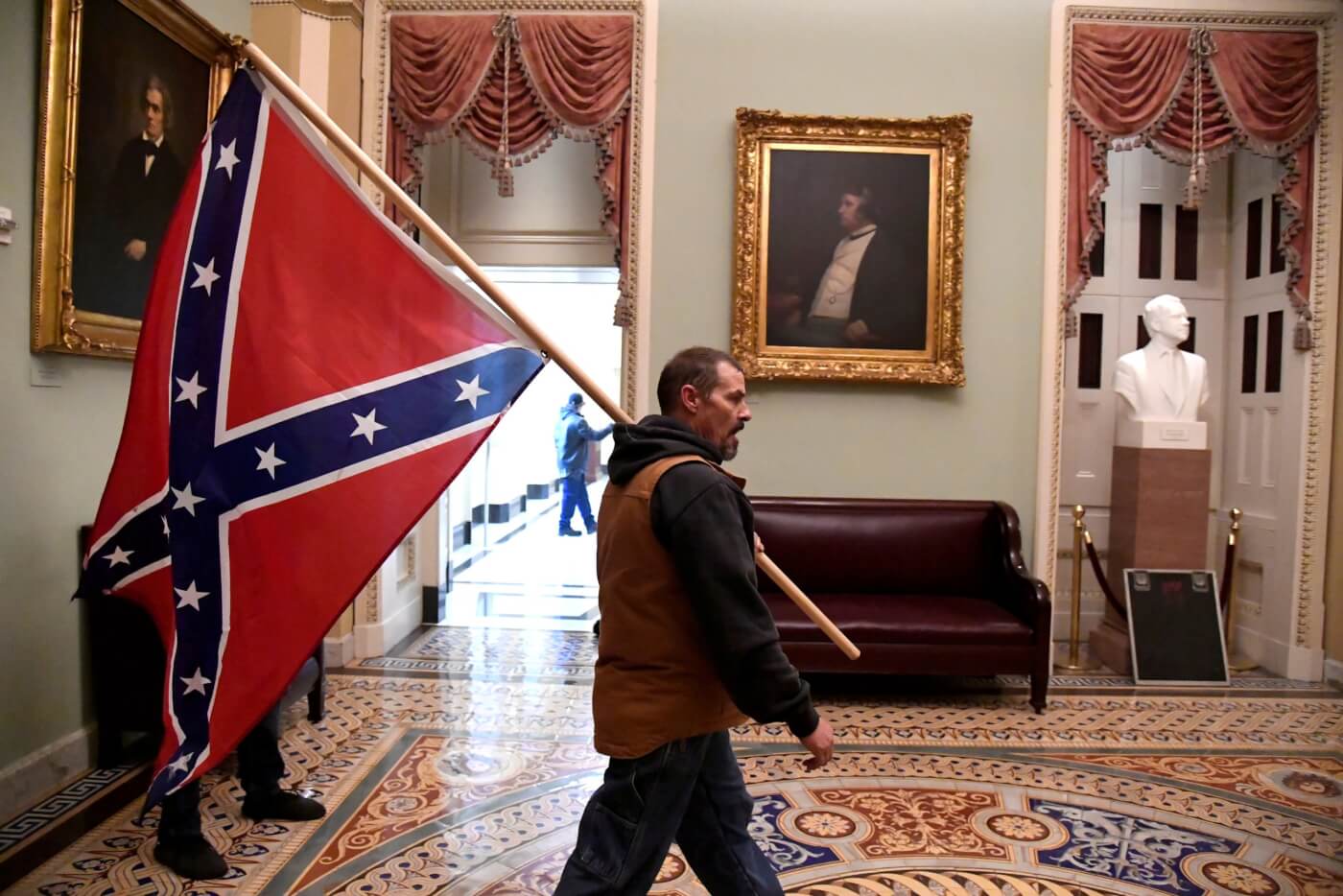The riots of the Capitol building left five dead, and 80 arrested. White supremacist militia groups, bearing Confederate flags, Trump merchandise and Nazi symbols, rampaged the federal government building, bypassing police and security forces with alarming ease.
Rioters were said to be making a siege after the election result that President Trump has repeatedly claimed as fraudulent. Earlier on 6 January 2021, the state of Georgia confirmed a Democratic win, officially turning the Houses of Congress majority blue. In scenes that shocked the world, rioters were able to completely infiltrate the Capitol building, forcing government officials into hiding, destroying property and even taking photos on the Senate floor.
Much of the riots were being documented and watched via live stream news coverage through social media. As Facebook and Twitter exploded with images and videos, millions of people were left asking: how could this have happened? Much of President Trump’s tenure since 2016 has oriented around his disregard for the media and brandishing his critics as “fake news.”
The term has become one of the most frequently used political buzzwords, but it fails to capture the dangers of online misinformation, disinformation and malinformation.
Trump’s incitement of the violence and rioting led to unprecedented moves by social media companies, with Twitter and Facebook removing several of the President’s social media posts and locking him out of his account for 24 hours.
But even though these were the right moves for Twitter and Facebook to take, it seemed long overdue and that the damage had already been done. The spread of misinformation has had clear impacts on the health and safety of others, both with the COVID-19 pandemic and the rising force of White supremacist and far-right groups. This has worrying consequences for human rights, risking harm to those who are targets of such groups and eroding democracy.
Misinformation, disinformation and malinformation
According to the Council of Europe’s Information Disorder Report of 2017, misinformation is defined as “information that is false, but not created with the intention of causing harm.” Disinformation, on the other hand, is “information that is false and deliberately created to harm a person, social group, organization or country.” Mal-information is “information that is based on reality, used to inflict harm on a person, organization or country.” The three are often conflated or brandished under the universal term of “fake news”, but the small distinctions are important to make.
For example, under President Trump’s tweets which claim Biden’s victory is illegitimate, there is a warning that “this claim about election fraud is disputed”, constituting misinformation. However, it could be argued that Trump’s tweets claiming the fraudulent election, which emboldened his supporters, are disinformation, because they cause deliberate harm to democracy and American citizens, as demonstrated by the riots. But the events of Wednesday were the culmination of years of harmful misinformation and disinformation. According to a tally created by The Washington Post, in Trump’s first 100 days in office he made 492 false or misleading claims, and by the final week of his 2020 reelection campaign, this figure was almost 25,000.
Far-right and white supremacist groups
People from all over the world travelled to attend the riots that took place on 6 January, gathering a range of far-right, white supremacist extremist groups in one place to defend President Trump’s false claims that the election was “stolen” from him and his supporters. Noted attendees of the rally were groups such as the Proud Boys, QAnon, Neo-Nazi group NSC-131, and prominent far-right extremists such white nationalist Groyper Army leader Nick Fuentes, and a man known as Baked Alaska, who lived streamed from House Speaker Nancy Pelosi’s office.
The mob brandished well-known white supremacist and far-right extremist symbols, such as Confederate flags, crusader crosses popularised by far-right ethnonationalist groups, swastikas, and one man spotted with a hoodie reading “Camp Auschwitz”.
The gathering of all these groups in Washington DC proved the success of the far-right’s extensive social media presence and network of online organisations. Far-right groups are structured in a decentralised manner, meaning there is no one single point of operation and organising can take place through various methods both online and offline. The far-right has typically operated in disguised online forums such as 4chan, but has entrenched further into mainstream media, as its presence has grown considerably across America and Europe in recent years. A 2018 report by Hope Not Hate found that whilst social media companies are increasingly removing far-right propagandists figures from their platforms, there is still an upward trend in online hate.
The mob that descended on the Capitol resulted from weeks of planning and organisation by the far-right, empowered by Trump’s incitement. Websites such as Parler, Gab, TheDonald and MeWe are some of the forums used to spread conspiracy theories, disinformation and lies about the election result, according to research fellow at the Atlantic Council’s Digital Forensic Research Lab Jared Holt. Holt notes that the lies spread “often came from the top arbiters of power in the Republican Party, notably President Donald Trump himself.”
Advance Democracy found “more than 1,480 posts from QAnon-related accounts about Jan. 6 that contained terms of violence since Jan. 1. On TikTok, videos promoting violence garnered hundreds of thousands of views.”
After the storming of the Capitol, traffic increased by 40% on Gab, and 80% of the top posts on TheDonald relating to the Electoral College result featured calls for violence. Holt says that when it became clear that Vice President Mike Pence was not going to reject the election results, many right-wing extremists decided to take matters into their own hands. Trump’s encouragement to his supporters to protest at the Capitol was the final push needed for dispersed far-right and white supremacist advocates to culminate in one place and wreak havoc.
Whilst President Trump later posted a video on Twitter asking for peace and to respect law and order, the display of power and ability of the far-right to come together poses a heightened risk to fundamental features of democracy and human rights. Many of the groups who participated in the riot weaponise conspiracy theories such as the “great replacement” theory, that Muslims are taking over their country, or Holocaust denials. The display of neo-Nazi symbols and Confederate flags at the riots jeopardises the safety of Jewish people, African Americans, and other religious and ethnic minorities. Coupled with Trump’s comments on the Black Lives Matter protests, deeming them “looters and thugs” back in July 2020 and fuelling polarised divisions, the potential for increased violence towards ethnic and religious minority communities, in the coming weeks with President-elect Biden’s upcoming inauguration, is one of great concern.
Trump and the COVID-19 “infodemic”
During the ensuing violence of Wednesday afternoon, it was momentarily forgotten that COVID-19 is still at large and the death toll in America is continually rising. As well as spreading disinformation on the “stolen election”, far-right groups have had a hand in spreading false information and conspiracy theories regarding COVID-19. Popular theories align with white supremacist agendas, such as espousing xenophobic rhetoric of the “Chinese virus” as a bioweapon from Wuhan, or COVID-19 is a hoax to restrict the freedoms of Americans and increase “deep state” and government control, or deeming COVID-19 an “Islamist threat”.
With the concerning spread of disinformation around COVID-19 or the election results, many fact-checking and counter-misinformation measures simply can’t keep up with the damage that has been done. Similarly to his claims of a fraudulent election, the far-right have been emboldened by Trump’s disregard for health and science. Regardless of content warnings, Trump’s misleading words are ingested by his supporters with little care for fact or fiction. It has fostered a dangerous climate in which people do not trust legitimate news sources and readily support whatever falsehoods that Trump puts out.
An “infodemic” is an overabundance of information, both online and offline, according to the World Health Organisation (WHO), including “deliberate attempts to disseminate wrong information to undermine the public health response and advance alternative agendas of groups or individuals.”
WHO Director-General Tedros Adhanom Ghebreyesus stated that “we’re not just fighting an epidemic; we’re fighting an infodemic”, as global communication companies, health organisations and governments work to ensure people receive legitimate and credible information.
Trump’s rhetoric on the COVID-19 pandemic, from denial, calling it the “China virus”, suggesting dangerous methods of ridding it, to claiming he is “immune” and cannot spread it to others despite catching the virus, is in opposition to those efforts. The Cornell Alliance for Science conducted a study of 38 million English-language news articles from media sources worldwide, and found that 1.1 million of them “disseminated, amplified or reported on misinformation related to the pandemic.” Topics of misinformation and disinformation ranged from conspiracy theories to threats and attacks against the Director of the National Institute of Allergy and Infectious Diseases, Dr. Anthony Fauci.
Sarah Evanega, Director of the Cornell Alliance for Science commented that “if people are misled by unscientific and unsubstantiated claims about the disease, they may be less likely to observe official guidance and thus risk spreading the virus.” The most popular topic was found to be “miracle cures”, fuelled by President Trump’s comments such as suggesting the potential use of disinfectants back in April and the unproven treatment of hydroxychloroquine. The second most popular topic was the allegation that the virus is a creation to advance the “new world order/deep state”, with “COVID-19 being a hoax perpetrated by the Democrtatic Party for political gain” following in third place. The conspiracy theory that COVID-19 is a “bioweapon intentionally or accidentally released by a laboratory in Wuhan” was the fourth most prevalent topic.
The study found that President Trump was “quite likely the largest driver of misinformation during the COVID pandemic to date”. The authors of the study noted how such a huge amount of misinformation was directly linked to public comments made by a small number of individuals like the President.
Such findings highlight the dangerous nature of misinformation, given that America has the highest number of global cases (21.7 million) and death toll (365,000). On 7 January 2021, a record number of people in the US died from COVID-19 in one day: 3,998, one death every 21 seconds. The APM research lab found that “Black and Indigenous Americans continue to suffer the highest rates of loss—with both groups now experiencing a COVID-19 death toll exceeding 1 in 750 nationally”. So, whilst many Americans reflect Trump’s rhetoric of COVID conspiracy theories, the health and safety of minority communities is put at greater risk.
The Cornell Study only focused on news articles; the spread of misinformation and disinformation via social media channels is also to be considered. Data from the Bruno Kessler Foundation found that from an analysis of 112 million public social media posts related to COVID-19 in 64 different languages, 40% of posts came from unreliable sources. This spans across Facebook, Twitter and other major social media platforms. Researchers also found that almost 42% of over 178 million tweets related to COVID-19 were produced by bots, and 40% were “unreliable”. On Facebook, 40 million posts in March were deemed “problematic” and had warnings placed on them, and the site removed hundreds of thousands of posts containing misinformation about the virus that could “lead to imminent physical harm”.
With Trump’s presidency drawing to a close, his supporters remain adamant that the election was taken from them, and a Biden presidency threatens what they stand for. More vigorous action is needed by social media platforms and global communication bodies to shut down the online presence of far-right extremism, disrupting their organisational abilities and making it harder to spread harmful messages. Whilst much of the commentary of Wednesday’s events focuses on the threat to American democracy, the real threat is to the minority communities who are made targets of white supremacists and far-right extremists.

